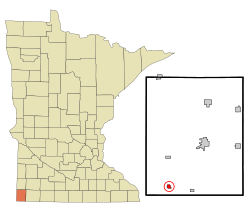Hills, Minnesota facts for kids
Quick facts for kids
Hills
|
|
|---|---|
 |
|
| Motto(s):
Tree City USA
|
|

Location of Hills, Minnesota
|
|
| Country | United States |
| State | Minnesota |
| County | Rock |
| Government | |
| • Type | Mayor - Council |
| Area | |
| • Total | 0.64 sq mi (1.66 km2) |
| • Land | 0.63 sq mi (1.63 km2) |
| • Water | 0.01 sq mi (0.03 km2) |
| Elevation | 1,486 ft (453 m) |
| Population
(2020)
|
|
| • Total | 686 |
| • Density | 1,088.89/sq mi (420.68/km2) |
| Time zone | UTC-6 (Central (CST)) |
| • Summer (DST) | UTC-5 (CDT) |
| ZIP code |
56138
|
| Area code(s) | 507 |
| FIPS code | 27-29204 |
| GNIS feature ID | 2394383 |
| Website | http://www.hillsmn.com/ |
Hills is a small city located in Rock County, Minnesota, in the United States. It is very close to the borders of South Dakota and Iowa. This makes Hills the city furthest southwest in Minnesota. In 2020, about 686 people lived there.
Contents
About Hills' Location
Hills covers a total area of about 1.66 square kilometers (0.64 square miles). Most of this area is land, with a small part being water. The land around Hills is mostly flat, with some gentle, rolling hills. Even with its name, the city isn't named after a specific hill nearby.
Parks and Recreation
The city has two parks for people to enjoy: Jacobson Park and the Rez. The Rez is a special place because it's a man-made reservoir. People use it for swimming, fishing, and other outdoor fun. There's a gravel path around the Rez, perfect for walks. You can also find two small playgrounds there. If you like camping, there are campsites and a cabin available. Plus, there's a disc golf course for a fun game!
People of Hills
Hills has seen its population change over the years. Here's how many people have lived in Hills at different times:
| Historical population | |||
|---|---|---|---|
| Census | Pop. | %± | |
| 1910 | 398 | — | |
| 1920 | 418 | 5.0% | |
| 1930 | 407 | −2.6% | |
| 1940 | 450 | 10.6% | |
| 1950 | 520 | 15.6% | |
| 1960 | 516 | −0.8% | |
| 1970 | 571 | 10.7% | |
| 1980 | 598 | 4.7% | |
| 1990 | 607 | 1.5% | |
| 2000 | 565 | −6.9% | |
| 2010 | 686 | 21.4% | |
| 2020 | 686 | 0.0% | |
| U.S. Decennial Census | |||
In 2010, there were 686 people living in Hills. Most residents were White (98.0%). About 24.5% of the people were under 18 years old. The city had slightly more females (52.0%) than males (48.0%).
Hills' History
The city of Hills was first planned out in 1889. It was named after Frederick C. Hills, who was an official for the railroad. A post office opened in Hills in 1890. The city officially became an incorporated city in 1904.
Farming in Hills
Farming is a very important part of the local economy in Hills. The main crops grown in this area are corn and soybeans. These crops are a big source of income for the region.
Education in Hills
The school system in Hills joined with the Beaver Creek school system in 1965. This created the Hills-Beaver Creek (H-BC) school district.
School Campuses and Mascots
The high school, which teaches grades 6 through 12, is located in Hills. The elementary school, for grades Pre-Kindergarten through 5, is in Beaver Creek. The school mascot is the Patriots, and their colors are red, white, and blue.
School Achievements
In 1990, the Hills-Beaver Creek football team won the 9-man Minnesota State High School League Championship. They played that exciting game at the Metrodome. The schools have also received national recognition. In 2019, Hills-Beaver Creek Elementary was given the National Blue Ribbon School Award. This award honors schools that perform at the highest levels in the nation. Then, in 2024, Hills-Beaver Creek Secondary also received the National Blue Ribbon School Award as an Exemplary High Performing School.
See also
 In Spanish: Hills (Minnesota) para niños
In Spanish: Hills (Minnesota) para niños

